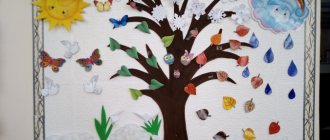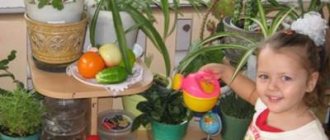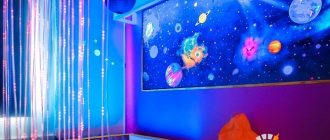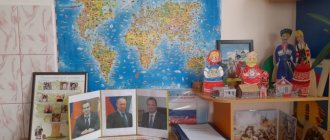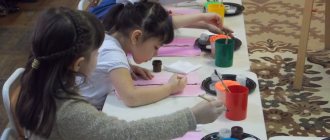- Where to begin?
- For boys
- Reception
Decorating a group room in a preschool institution for each teacher and parents becomes not just a responsibility, but also a creative process. It implements unique ideas and experiences, sometimes from several generations. In this article we will not only describe, but also place various corners in kindergarten in pictures. We hope that our site and this article will be useful to you. Well, let's get started.
Where to begin?
Before you start decorating a group in a kindergarten and creating various thematic corners in a kindergarten, you should definitely take care of the general decoration inside the group . When painting, you should not use a lot of bright colors. It is better if the tone of the main paint is light and “warm”:
- beige,
- peach,
- pearl and so on.
Photo wallpapers with characters from fairy tales and cartoons, as well as stickers with children's themes, look good in children's groups.
It is better to decorate all the group’s rooms in the same style and think in advance about a theme that will tie together the bedroom, reception area, study area and play corners in the kindergarten. Before you start designing specific corners, you should consult with your parents, discuss together and get acquainted with possible options for children of different ages. Here are some corners that can be organized in a kindergarten; for an example, see the photo.
Developmental environment
Play space
Traditionally, each group has a separate room for a bedroom, and the common group room is divided into an activity area and a play area. Play corners for kindergarten are designed differently depending on the age of the children in the group, free space and the creative scope of the organizer. For example, in the play area, a separate place is often allocated for a mummering corner in a kindergarten.
The location for it must be chosen with special care, it must be easily accessible and constantly open to children. The purpose of its design is to create conditions in the group for the creative activity of children, the development of imagination, the formation of gaming skills, the implementation of gaming plans, and the cultivation of friendly relationships between children. You can decorate such a place in the form of a model house, a stylist’s office, or a small screen with a variety of outfits:
- professions,
- animals,
- artists,
- fairy tale heroes and so on.
Once the location has been determined and the design option has been selected, you can begin the practical part. The boundaries of the corner are formed using furniture. This could be: a low rack with shelves, drawers and a crossbar for clothes hangers. For convenience, a table and chairs can be located in the corner. A mandatory attribute in the mummers' corner should be a mirror where children can examine and evaluate their appearance. You can paste pictures of various suits, hats and other items of clothing on the wall.
Design options
Sometimes a hairdresser’s corner in a kindergarten fits harmoniously into such a corner. Here everything is ready to equip the hairdresser’s workplace - a table, a chair for the client, a mirror. On the table you can put bottles, combs, hair decorations, etc. You can glue pictures of scissors and combs on the wall. The apron for the master can be located on one of the hangers on the crossbar.
If space allows, the hairdressing salon corner in the kindergarten is designed separately, as an independent area for the role-playing game “Barbershop”. First, the necessary furniture and shelves are also installed. Instead of a rack with outfits, you can place a bedside table or mini-wardrobe with hairdressing supplies. You can also sew wall pockets for them. Then game items are added. Usually such a place is made as a children's corner for a girl, based on an interest in hairstyles, jewelry, and so on.
What do you need to know about SanPiN in preschool institutions?
Sanitary and hygienic rules and regulations for preschool institutions are approved by SanPiN 2.4.1.3049-13.
The act, approved by the Decree of the Chief Sanitary Doctor of the Russian Federation dated May 15, 2013 No. 26, includes rules governing the organization of the organization and the rules for the use of accessories for children accepted into groups.
The act establishes requirements for:
- location of the preschool educational institution;
- equipment, including its location;
- maintenance of territories related to a children's educational institution;
- maintenance, decoration of premises, the building itself;
- lighting of rooms, as well as auxiliary premises (natural and artificial);
- heating, water supply, ventilation, sewerage and other systems;
- the formation of groups that accept children with diseases that limit their health;
- admission of minors to organizations implementing preschool education programs;
- organization of the regime and educational process, including training;
- equipment, inventory, toys, dishes and equipment in the catering department;
- conditions of preparation, storage of food, menu preparation;
- transportation, food intake;
- hygienic, anti-epidemic measures;
- compliance with sanitary standards.
All of the above requirements must be strictly observed by employees of preschool institutions.
For refusal to comply with the rules, citizens and organizations face a hefty fine. Next we will talk about labeling furniture and utensils in preschool educational institutions.
For boys
However, there must be a place for boys to play in the play area. A children's corner for a boy may take up a little more space than for a girl. The main requirements for its location also remain convenience and accessibility for children. Such corners are created to take into account the gaming interests of children of different sexes, their differentiation and the development of gaming activities in general.
Design options are chosen based on the interests of the majority of boys in the group and general “boy” themes. For example:
- car showroom,
- nautical theme (ship),
- workshop,
- military base,
- or a corner of space in kindergarten.
Outer space will be interesting and useful for children of senior preschool age. With its help, children will gain basic knowledge about space, planets, and spaceships in a playful way.
The color scheme of such a corner is determined by the theme.
These are the shades:
- blue,
- purple,
- white and yellow colors.
It would be good if the furniture for the corner was made in the same colors. If the group’s budget does not allow you to buy new furniture, you can use self-adhesive film of the desired color and texture. On the floor you can place a rug with a space theme (lunar surface, meteorite). A simple model of the solar system must be present - either as a poster on the wall, or paper planets in volumetric form, hanging from the ceiling.
Color solution
Interior design and architecture
All materials in the playroom, including construction materials, must have certificates confirming their origin, quality and health safety. Also, materials must be resistant to wet cleaning and disinfection. In accordance with these requirements, the following options are possible for the design elements and architecture of the game room:
1) floor, walls, ceiling
. According to the standards, the area of the playroom for early age groups (children under 3 years old) is determined at the rate of at least 2.5 × 2.0 m per child, for preschool age (children 3–7 years old) - at least 2 .0 × 2.0 m. The following floor coverings are allowed: linoleum, parquet, cork flooring, carpet. You can put, for example, a puzzle mat on top. To paint the walls, choose matte light colors: sand, turquoise, cream, coffee, light pink, lilac, etc. The walls can be decorated with children's images, vinyl stickers, paper applications, posters, etc. The ceiling can be either a regular whitewashed or painted, tiled and fabric stretched;
2) windows, lighting, furniture
. Curtains or blinds in light colors are required on the windows. Lighting (warm, perhaps with a yellowish tone) should be general and uniform, without open spotlights or harsh light. The sizes of drawers, cabinets, shelving and other furniture are selected according to the age of the children. In this case, the color of the furniture is allowed to be bright.
Reception
The locker room or reception area is the first thing a child and his parents see when they bring their child to kindergarten. Therefore, its design must be taken seriously. For children, there is usually a mood corner in kindergarten. The purpose of such a corner is to create a favorable emotional environment in the group. Thanks to it, children learn to understand not only their own mood, but also the mood of their peers.
In the design of such a corner, ready-made stands or home-made models can be used. The principle of their design is the same: in several pockets there are pictures with different emotions (their number depends on the age of the children), pockets for photographs of children are attached to the bottom. Coming to the group, the child, together with a parent or teacher, determines his mood and places his photo in the pocket under the corresponding emotion.
If the mood changes during the day, the photo is rearranged. Emotions can be depicted in the form of emoticons and cartoon characters. An approximate list in the older group could be: joy, fun, calm, surprise, sadness, anger.
note
It’s worth paying attention to the corner of the menu in kindergarten. The purpose of its creation is to familiarize parents with the child’s diet outside the home, as well as the basic principles of nutrition for preschool children. We can decorate it as a ready-made stand or manually (with painted pictures on the theme of the group, in the form of three-dimensional figures made of salt dough). Usually it has several pocket compartments. They contain a daily menu, as well as rules for feeding children.
Find out how to make a children's playground out of logs with your own hands in our material! You will learn how to properly make clothes for children in our article!
At https://karuselkin.ru/sad-i-shkola/kak-organizovat-i-provesti-detskij-novogodnij-utrennik/ link you will find interesting scenarios for the New Year.
If entering kindergarten is not an urgent problem, and you are just preparing to become parents, then you can beautifully decorate the room for your child by organizing children's corners for newborns. Usually they provide a sleeping place for the baby, a changing place and a place for clothes and toys. The colors of furniture and wallpaper should also be chosen soothing and light. You can paste a few funny pictures of children's toys. Soft toys are excluded in such a corner. So, the options for children's corners can be varied, the main thing is that they are aesthetically designed, safe and interesting for children.
Principles for designing a playroom in a preschool educational institution
1. Zoning
. It is necessary to divide the playroom into zones with different types of toys. This will avoid mixing gaming and educational processes.
2. Safety
. There should be no dangerous places in the room. You should stick soft corners on sharp corners, use plugs for heavy doors (stoppers), install limiters on windows for ventilation, purchase curtains for sockets, hide all wiring, and also pay attention to the floor - it should be smooth and warm.
3. Comfort
. Arranging a playroom begins with preparatory work. It is important to provide a suitable microclimate: temperature, humidity, lighting, fresh air flow. To monitor environmental indicators, it is better to install a weather station.
4. Saturation and variability
. The equipment of the game room should be varied and colorful. This will not only give children a choice, but will also decorate the room. It is desirable that the equipment provides all types of activity: motor (including fine and gross motor skills), cognitive, research, creative, joint. Also, do not forget to periodically update the game material.
5. Availability
. The playroom equipment should be located within the child’s reach so that he can use it independently at any time. Toys must be in good working order, appropriate for the age, and, if necessary, the limitations of the children.
6. Transformability and multifunctionality
. You will be able to use your budget rationally with equipment that is interesting to children of different ages and has various options for use. For example, soft modules are suitable for relay and building games, as well as for recreation. At the same time, both babies and older children (preschoolers) love them.
